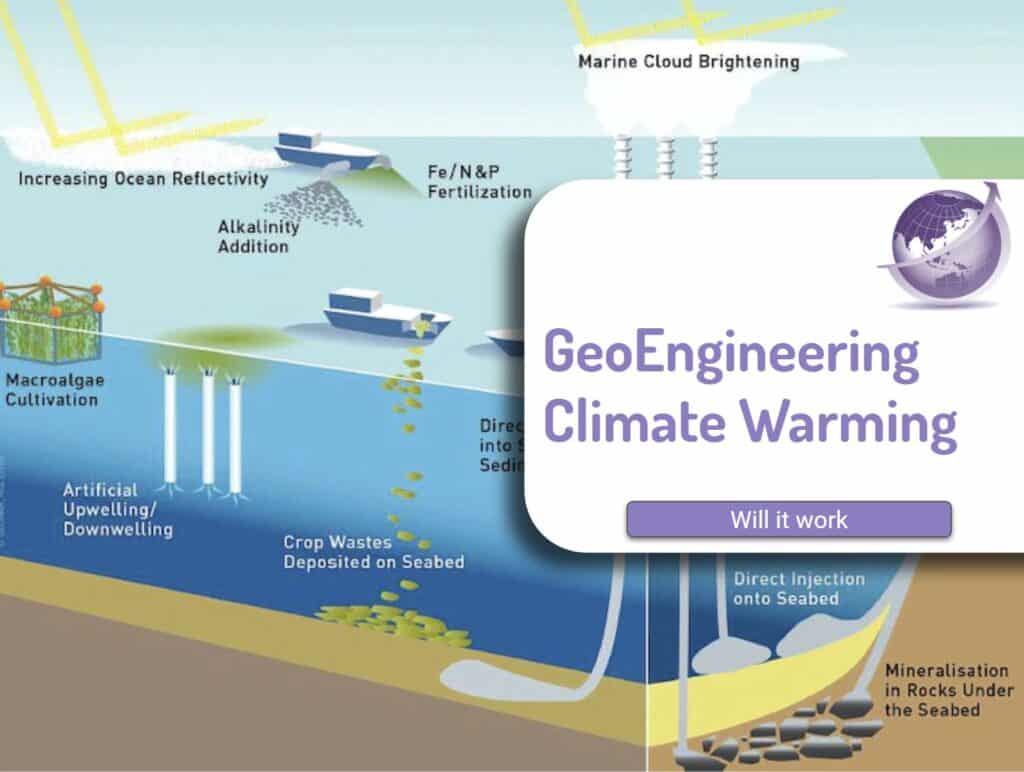Solar geoengineering for climate warming may be a ‘fire extinguisher’ and bring temperatures down by 1o and at a cost less than many of the other climate change remediation opportunities. For a good podcast from Physics World in Mar 2022 listen to the pros and cons of injecting large amounts of aerosols into the atmosphere to offset global warming.
Many Geoengineering Options
Many options are proposed for solar radiation management (SRM). These are discussed in detail in Carbon Brief. While they deal with some issues of climate change, they don’t address ocean acidification and other issues. Wikipedia References
- Stratospheric aerosol injection – sending sunblocking particles into the stratosphere
- Marine Cloud Brightening – sraying seawater thousands of metres into the air to seed the formation of stratocumulus clouds that will deflect sunlight
- Space Sunshanes – installing sun-shields or mirrors in space to reflect the sun
- High-albedo crops and buildings but unlikely to make much difference, except in cities
- Ocean mirror – by creating foam, or microbubbles to reflect more sunlight.
- Cloud thinning- removing cirrus clouds which adsorb sunlight and heat up.
Cost of SAIL-1
In 2018 Dr Wake Smith at Yale University and Gernot Wagner at Harvard University proposed the SAIL-1 system. Sail is a Stratospheric Aerosol Injection Lofter Aircraft Concept which would use special large-winged aircraft to disperse 15 tons of sulfate or calcite aerosol particulates at 20 km (65,000 feet). To maintain a 1 °C cooling effect, this would cost about $43bn per year to operate. Subsequent publications by them to release material at 25km rather than 20km, demonstrated the trade-off from less product required., to aeronautical problems with release at higher altitudes. Gernot Wagner has a book called Geoengineering – the Gamble
Engineering versus Political
While the technology would reduce temperatures by 1o, the challenge is that every country would be affected due to the mixing in the stratosphere, so if one country launched the product, then everyone would be impacted as the wind moves both east west but also from Arctic to Antarctic. The product would be shorted lived, about 1 to 2 years, compared with CO2 that lasts for decades or millenia.
GeoEngineering for climate warming works
Solar geoengineering offers a way of mitigating the effects of global warming by reflecting incoming sunlight back into space – thereby cooling the Earth. One way of doing this is to inject aerosols into the atmosphere. Scientists and engineers know that this works because of the historical cooling that occurred after major volcanic eruptions, which injected vast amounts of material into the atmosphere. (Physics World)
The SAIL-1 option would about $43bn per year to achieve a 1° cooling effect
How to Launch Particles to Height
The researchers propose one of 5 methods
- A rocket assisted version of SAIL-1;
- A supersonic ballistic climber derived from the F-15C fighter jet;
- Two-stage mothership and rocket-powered drone that are modelled on Virgin Galactic technology.
- The Lockheed SR-71 Blackbird supersonic reconnaissance aircraft
- Boeing 747–400 cruising at 12 km as a platform to hurl aerosol-containing mortar shells to 25 km.
Alternatives To Geoengineering
Dr Wake Smith stresses that although geoengineering will reduce the warming, we should not stop the other climate change mitigation such as stopping burning fossil fuels by electrifying the energy grid, electrification of the transport sector and stopping emissions from mining and agriculture. He does point out that while the engineering is feasible, the politics are less likely.
He says do mitigation first. Remediation is an option if we are unsuccessful at mitigation.
Methods Proposed for GeoEngineering for Climate Warming










